Chapter 7: Public Human Resources Management
Picture this: It was 1828 and the United States was seeing a showdown between “J. Q. Adams, who could write,” and “Andy Jackson, who could fight.” This election stands as one of the most contentious in American history. Jackson’s supporters accused Adams of being an elite who had used his position in society to gain the presidency. They also accused Adams of misappropriating public funds for his own personal gain and said had introduced gaming tables into the White House. They even spread rumors about Mrs. Adams, suggesting she was born out of wedlock, which was very scandalous at the time.
In response, Adams’s supporters spread a story that Jackson had been living with his wife before she was divorced from her first husband (this was actually accurate, but she had thought he was deceased). They disparaged the general, labeling him a slave trader, a gambler, and basically a “stupid redneck.” An editor in Philadelphia even published a picture depicting the coffins of men allegedly killed by Jackson in duels.
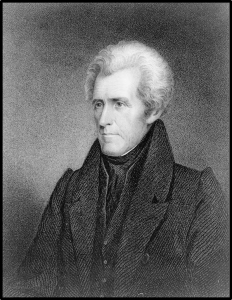
In some ways, Jackson really had come from an underprivileged and rural early life. He had pulled himself up by the proverbial bootstraps. He entered the world in 1767 in a log cabin, in the rugged region bordering North and South Carolina. Tragically, his father, a small farmer from Northern Ireland, passed away before he was born. To make things worse, his mother and two brothers died during the Revolution. At only 13 years old, Jackson enlisted in the American Revolution, where he fought and spent time in captivity.
Eventually Jackson rose from poverty and achieved a prominent career in law and politics, serving as Tennessee’s first congressman, senator, and state supreme court judge. Initially aligning with the state’s elite through marriages, business, and politics, he grew rich as a land speculator, cotton planter, and attorney, with ownership of over 100 enslaved individuals. His presidential candidacy gained support from speculators, creditors, and Tennessee’s elite, aiming to leverage his popularity against anti-banking sentiment.
As president, Jackson greatly expanded executive authority, promoting the idea that the president represented all Americans, unlike regional congress members. He advocated “democratic republicanism,” emphasizing the wisdom and self-governance of common people and distrusting the “better classes.” Jackson and his supporters perceived a fundamental conflict between working people and non-producers, attributing wealth and power inequalities to monopoly, favoritism, and privilege. They championed open competition in a free market to ensure wealth distribution based on hard work and ingenuity.
One key part of Jackson’s commitment to openness was his theory of rotation in office, popularly known as the spoils system. In his first annual address to Congress, Jackson argued that public offices should be regularly filled with party supporters to align with the nation’s republican ideals. According to Jackson, public office did not demand exceptional intelligence or training, and rotation in office prevented the emergence of a class of corrupt civil servants detached from the people. His supporters viewed the spoils system as a practical political strategy, a way to reward party loyalists, and fortify the party organization. Senator William Marcy of New York, a Jacksonian, famously declared, “To the victor belongs the spoils.”
The Spoils System
The 19th-century spoils system awarded government jobs based on political loyalty, allowing the incoming party to replace previous administration’s supporters. However, while Jackson appointed some supporters, it was less revolutionary than it seems. He replaced fewer than 1,000 of 10,000 civil servants for political reasons in his first 18 months, and fewer than 20% of federal officeholders changed during his presidency. The spoils system was not new, as several states, including New York and Pennsylvania, practiced political patronage before Jackson’s time.
The key characteristic under the spoils system was political patronage. Under the spoils system, the incoming political party or administration were allowed to award government jobs to individuals based on their political loyalty and support. When a new party came to power, it believed it had the right to fill government positions with its own supporters and remove those affiliated with the previous administration, leading to a system of patronage where political connections were often more important than qualifications or merit. This also led to nepotism, where political leaders appointed their relatives and close associates to government positions, regardless of their qualifications. This practice not only undermined merit-based hiring but also concentrated power and influence in the hands of a few political elites and their families.
Unsurprisingly, the spoils system fostered an environment ripe for corruption. Since government jobs were handed out as political rewards rather than based on qualifications, unscrupulous individuals often sought public office purely for personal gain. This could involve bribery, kickbacks, and other forms of graft, where government officials used their positions for personal enrichment rather than serving the public.
One notable example is the case of Samuel Swartwout, who served as the Collector of Customs for the Port of New York during President Andrew Jackson’s administration in the early 1830s.
Swartwout’s case gained notoriety because of his extensive embezzlement of funds. As the Collector of Customs, he was responsible for collecting tariffs and customs duties on imports arriving at the port. Instead of depositing these funds into the government’s accounts, Swartwout began embezzling large sums of money over several years. His theft amounted to an astonishing $1.25 million (equivalent to tens of millions of dollars today). Swartwout’s actions highlighted the weaknesses of the spoils system, as he had received his position as a reward for his political support of President Jackson. His embezzlement scheme continued for years before he was finally caught. By that time, he had fled the country, evading prosecution.
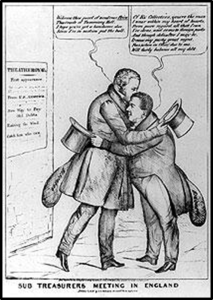
This high-profile case served as a stark example of how individuals appointed through the spoils system could exploit their government positions for personal financial gain. It contributed to growing public outrage over the corruption and inefficiency associated with the spoils system and ultimately played a role in the push for civil service reform to replace the spoils system with a more merit-based system.
Political loyalty often trumped competence when it came to staffing government agencies. As a result, many government offices were staffed with individuals who lacked the necessary skills or experience to perform their duties effectively. This inefficiency hindered the government’s ability to provide essential services and carry out its functions efficiently.
For instance, during James Buchanan’s presidency (1857-1861), he appointed many individuals to key government positions based on political patronage and loyalty rather than their qualifications or expertise. These appointees, often referred to as “Buchanan’s Loyalists,” were chosen for their support of the Democratic Party and the president himself. The result was a government riddled with inefficiency, corruption, and mismanagement. Many of Buchanan’s appointees lacked the necessary skills and experience to effectively carry out their duties. In some cases, government agencies were staffed with individuals who had no prior knowledge or expertise in the areas they were responsible for overseeing.
One of the most glaring examples of inefficiency during Buchanan’s presidency was the handling of the financial crisis of 1857. The individuals appointed to key positions in the Treasury Department and other financial institutions were ill-equipped to address the crisis, leading to a lack of effective response and exacerbating the economic turmoil.
The inefficiencies and scandals associated with Buchanan’s administration, largely a result of the spoils system, contributed to a growing demand for civil service reform and the eventual shift toward a more merit-based system in the United States. This reform aimed to ensure that government positions were filled by individuals with the necessary qualifications and expertise, rather than through political patronage.
The spoils system undermined public trust in government institutions. As political connections became more critical than competence for securing government positions, citizens grew skeptical of the government’s ability to serve their interests. This erosion of trust hindered the government’s ability to gain public support and cooperation. Political patronage left many citizens disillusioned with a system that seemed to prioritize rewarding political allies over addressing their needs. This disillusionment could lead to apathy, reduced civic engagement, and a perception that the government was disconnected from everyday citizens’ concerns.
One major scandal that certainly didn’t help people’s trust in the system was the Star Route Postal Fraud scandal. The Star Route mail delivery system was a network of privately contracted mail routes serving remote and rural areas. Contractors won contracts through competitive bidding, ostensibly awarded to the lowest bidder who could fulfill the requirements. However, a scandal emerged as contractors engaged in fraudulent activities to secure lucrative contracts. Key elements of the Star Route Postal Fraud included fictitious bidding, subcontracting at lower costs, political favoritism, inefficient route choices, and bribery of postal officials.
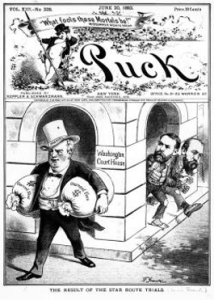
As the flaws of the spoils system became evident, reform movements began to gain traction. Advocates for civil service reform argued for a merit-based system where government positions would be awarded based on qualifications rather than political connections.
Undoubtedly, civil service reform was already in progress before the assassination of President James A. Garfield in 1881. However, it is undeniable that the assassination, perpetrated by a disgruntled job seeker, played a role in accelerating the reform efforts. Charles Guiteau, an individual who had identified as an attorney and had supported Garfield’s campaign, shot the president due to his frustration over not receiving a patronage appointment.
Thus, the spoils system eventually gave way to civil service reforms, notably the Pendleton Act of 1883, which marked the beginning of the shift towards a merit-based system of government employment. While the spoils system left a legacy of inefficiency and corruption, it also played a pivotal role in the eventual establishment of a more professional and non-partisan civil service in the United States.
The Pendleton Act and the Creation of the Civil Service
The Pendleton Act, officially known as the Pendleton Civil Service Reform Act, was a significant piece of legislation passed by the United States Congress in 1883. It marked a crucial turning point in the history of the U.S. civil service system by introducing reforms aimed at eliminating the spoils system and establishing a merit-based system for federal government employment.
The passage of the Pendleton Act in 1883 was driven by a convergence of influential factors. Foremost among these was the widespread public outcry against the prevailing spoils system, a system marred by corruption and inefficiency. Scandals like the “Star Route” postal fraud had shocked the nation and underscored the urgent need for reform within the federal government.
Civil service reformers, comprising politicians, journalists, and academics, had long been vocal proponents of change. They contended that transitioning to a merit-based system would not only eliminate political favoritism but also cultivate a more professional and efficient civil service that could better serve the nation.
Crucially, President Chester A. Arthur, who had previously benefited from the spoils system, emerged as a staunch advocate for civil service reform upon assuming office. His support was instrumental in pushing the reform agenda forward, culminating in the signing of the Pendleton Act in January 1883.
Additionally, the Pendleton Act garnered bipartisan support in Congress, reflecting a consensus on the necessity of reform. It passed the Senate by a vote of 38-5 and the House of Representatives by a margin of 155-47. This broad-based approval signaled a collective commitment to dismantling the spoils system and ushering in a new era of merit-based appointments in the federal government.
Key Provisions of the Pendleton Act:
The Pendleton Act sought to reform the civil service system in several ways:
- Merit-Based Hiring: The most significant change introduced by the Pendleton Act was the establishment of a merit-based system for federal employment. Under this system, candidates for government jobs had to be assessed based on their qualifications, skills, and experience, rather than their political connections.
- Civil Service Commission: The act created the United States Civil Service Commission, which was tasked with overseeing the implementation of the new merit-based system. The commission was responsible for conducting competitive examinations to assess the qualifications of job applicants.
- Civil Servant Protection: The Pendleton Act also provided protections for civil servants by prohibiting their removal from office for political reasons. Civil servants were now more secure in their positions and could not be dismissed solely because of a change in political leadership.
- Competitive Examinations: To determine the qualifications of job applicants, the Civil Service Commission introduced competitive examinations. These exams were designed to assess candidates’ knowledge and skills relevant to the positions they sought.
The Pendleton Act transformed the federal civil service system, reducing political patronage and establishing a professional and merit-based workforce. It was a significant step toward a more efficient and accountable government. The act laid the foundation for the modern civil service system in the United States, which continues to be based on principles of merit and professionalism.
State and Local Reform
After the enactment of the Pendleton Act in 1883, which initiated civil service reform at the federal level, many state and local governments in the United States began to follow suit, implementing their own versions of civil service reform to address issues related to corruption, patronage, and inefficiency. These reforms aimed to create a more professional and merit-based public service system, similar to what was being established at the federal level.
Civil service reforms at the state and local levels had a significant impact on government hiring and employment practices. These reforms were inspired by the federal Civil Service Commission and led to the creation of similar commissions or boards in many states and municipalities. Their primary mission was to oversee the hiring and promotion of public employees and introduce standardized processes and competitive examinations to ensure merit-based appointments.
One of the key outcomes of these reforms was the establishment of merit-based hiring practices at the state and local levels. Candidates were now required to pass competitive examinations, shifting the focus from political affiliations to qualifications and skills. This change effectively put an end to the spoils system, which had rewarded political supporters with government jobs.
Civil service reforms also aimed to protect civil servants from political influence. They introduced rules and regulations to prevent elected officials from interfering in personnel matters and safeguarded employees from arbitrary dismissals or demotions. Merit- based promotion systems were introduced to enable career advancement based on performance and qualifications, rather than political connections.
Professional development became a priority as well, ensuring that civil servants acquired the necessary skills for their roles. Transparency in hiring and promotion processes was emphasized, granting public access to information about job openings, examination results, and evaluation criteria.
Civil service reforms were implemented in various states and cities across the United States in the late 19th and early 20th centuries. Here are some examples of specific states and cities that undertook civil service reform efforts:
- New York City, New York: New York City was one of the early adopters of civil service reforms. The Tammany Hall political machine, known for its patronage and corruption, faced significant opposition. Reforms in the city, often referred to as the “Tweed era” reforms, aimed to replace patronage with merit-based hiring and promotions.
- Massachusetts: Massachusetts was among the first states to establish a civil service system. The Massachusetts Civil Service Commission, created in 1884, developed standardized examinations and hiring procedures for state and municipal positions. This served as a model for other states.
- Illinois: Chicago, in particular, implemented civil service reforms to combat political corruption. The city established a civil service commission to oversee hiring and ensure that city jobs were awarded based on merit rather than political connections.
- Pennsylvania: Pennsylvania introduced civil service reforms, with Philadelphia leading the way. The Philadelphia Civil Service Commission was established to regulate the hiring and promotion of municipal employees, reducing the influence of political machines.
- Ohio: Ohio implemented civil service reforms at both the state and local levels. The state established a civil service commission in 1913, and cities like Cincinnati and Cleveland followed suit with their own civil service systems.
- Wisconsin: Wisconsin adopted civil service reforms as part of its broader progressive movement. The state implemented a civil service system in the early 20th century, emphasizing merit-based hiring, open examinations, and protections against political interference.
- San Francisco, California: San Francisco implemented civil service reforms to address corruption in city government. The city established a civil service commission to oversee personnel matters and ensure fairness in hiring and promotions.
- New Jersey: New Jersey introduced civil service reforms, with the New Jersey Civil Service Commission playing a central role. The commission was responsible for developing standardized testing and hiring procedures for state and local government positions.
These examples showcase the spread of civil service reforms from the federal level to various states and municipalities. While the specific details and timing of reforms varied, the overarching goal was to create a more professional and accountable public service by reducing the influence of political patronage and promoting merit-based hiring and promotion.
The emergence of nonpartisan city managers after World War I brought forth challenges to the existence of independent civil service commissions. These reform-minded city managers faced limitations on their authority over personnel, leading them to advocate for integrating the personnel function with other administrative functions under executive control. While this idea gained traction in some areas with established city manager systems, it had limited relevance in larger cities.
In many sizable cities, the initially implemented merit system provisions had deteriorated into a mere facade. This decline occurred through the appointment of individuals unsupportive of merit system principles as civil service commissioners and the withholding of appropriations to hinder the commission’s work. To counter these tactics, many jurisdictions later enacted ordinances mandating a fixed percentage of the annual budget for merit system administration.
Despite its less promising beginnings, the merit system took root in most significant public jurisdictions. Two key factors contributed to its expansion at the state and local levels. First, as state and local employment evolved, appointees based on political patronage gave way to individuals with technical expertise and a genuine interest in public service careers. Second, the federal government actively promoted the development of robust merit systems in states and localities, introducing measures to encourage adoption when federal funding was involved.
Interestingly, the commission-based approach to administering merit systems gradually declined at both federal and local levels. Independent personnel agencies with regulatory roles faced challenges in meeting the needs of elected executives and public managers. The establishment of civil service commissions initially aimed to eliminate the negative aspects of the spoils system but also unintentionally separated personnel administration from general management, presenting a central dilemma in contemporary public personnel administration.
The Civil Service Reform Act of 1978
The Civil Service Reform Act of 1978, also known as the Civil Service Reform and Executive Reorganization Act, was a landmark piece of legislation that brought about significant changes in the United States federal civil service system. Enacted on October 13, 1978, during the presidency of Jimmy Carter, the act aimed to modernize and improve the efficiency and effectiveness of the federal government’s personnel management. The Civil Service Reform Act of 1978 introduced several key provisions that reshaped the federal civil service system. One of the central changes was the establishment of the Office of Personnel Management (OPM), which replaced the Civil Service Commission and took on the responsibility of overseeing and managing the federal workforce. This change marked a shift towards a more centralized and organized approach to personnel management.
Another crucial aspect of the act was its emphasis on a merit-based personnel system. It aimed to reduce the influence of political patronage and nepotism in federal employment decisions, ensuring that qualifications and performance were the primary criteria for hiring and advancement. Performance-based pay was introduced, allowing for greater flexibility in determining compensation and recognizing outstanding performance.
The act also granted federal employees the right to engage in collective bargaining and union activities, providing a legal framework for labor-management relations in the federal sector. This change allowed federal workers to negotiate employment conditions, including wages and working conditions.
The creation of the Senior Executive Service (SES) was another significant development. This personnel system was designed for high-level federal executives, emphasizing qualifications and performance. SES members serve in leadership roles and contribute to attracting and retaining top talent in the federal government.
Disciplinary procedures for federal employees were streamlined and simplified, enabling agencies to address performance and conduct issues more efficiently. Additionally, the act codified nine merit system principles that agencies must adhere to, promoting fair and open competition, equal opportunity, and protection against prohibited personnel practices.
To safeguard whistleblowers, the act established protections for federal employees who report misconduct, fraud, waste, or abuse within their agencies. The Office of Special Counsel (OSC) was created to investigate whistleblower complaints, ensuring accountability and transparency.
The Civil Service Reform Act of 1978 had a profound impact on the federal civil service system. It modernized personnel management, promoted merit-based hiring and performance recognition, facilitated labor-management relations, and established essential protections for federal employees. These provisions continue to shape federal workforce practices and labor relations, contributing to the efficiency and professionalism of the federal government.
Looking Ahead
Personnel management in government underwent a significant transformation during the reinventing government movement. The 1993 National Performance Review, often referred to as the Gore Report, highlighted civil service reform as a central theme, emphasizing the need to revamp various aspects of the personnel system, including recruitment, hiring, classification, promotion, pay, and reward systems. A key overarching objective of this reform agenda can be summarized in a single word: decentralization.
Consequently, the federal government implemented several changes:
- Deregulation of personnel policy involved the gradual phasing out of the extensive 10,000-page Federal Personnel Manual and all agency-specific directives that implemented it.
- Departments and agencies were granted the authority to independently manage their recruitment and examination processes for all positions, leading to the elimination of central registers and standard application forms.
- The classification system was significantly simplified to provide agencies with greater flexibility in classifying and compensating their employees.
- Agencies were empowered to create their own performance management and reward systems, with the primary goal of enhancing individual and organizational performance.
- Efforts were made to reduce the time required for the termination of federal managers and employees for cause, aiming to expedite the process by half.
These reforms represented a substantial shift toward decentralization and aimed to streamline and modernize the federal government’s personnel management practices to improve overall efficiency and effectiveness. We continue to see the effects of these shifts today.
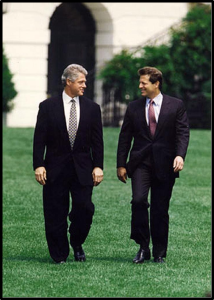
The primary objective of those spearheading the reinvention of public personnel administration was to instill a continuous customer-centric ethos within government personnel offices. This vision is articulated in the Gore Report, which emphasizes the imperative for personnel officers to evolve from being passive processors of paperwork to becoming proactive consultants and advisors. This transformation necessitates a fundamental shift in perspective, where personnel officers view federal managers as their primary customers, diligently anticipating and fulfilling their needs through responsive service.
This transformation marks a significant departure from conventional practices. Here, the focus shifts decisively toward the manager as the foremost customer, with their requirements taking precedence. Traditional concerns of public personnel agencies, such as safeguarding employees’ rights and upholding the integrity of the merit system, have been reassigned to appeals agencies like the Merit Systems Protection Board and to public employee unions.
Merit
Merit-based hiring and professionalism continue to be the cornerstones of the American public personnel systems. Governments prioritize selecting employees based on qualifications, competence, and experience, maintaining a workforce equipped with the necessary skills for effective job performance. Central to this ethos is the unwavering emphasis on selecting employees through merit-based processes. In this context, merit is the foundational criterion upon which government recruitment decisions are founded. Qualifications, competence, and experience are not mere buzzwords but essential benchmarks by which candidates are evaluated. This rigorous approach ensures that individuals appointed to public positions possess the requisite skills, knowledge, and capabilities to excel in their roles. It transcends political considerations, fostering a workforce defined by its competence and dedication to the public interest.
By placing qualifications and competence at the forefront of hiring decisions, the public personnel systems play a pivotal role in shaping the caliber of government employees. The rationale behind this approach is straightforward: to deliver efficient and high-quality public services, agencies must be staffed with individuals who possess the expertise and aptitude needed to tackle the myriad challenges of governance.
Furthermore, this commitment to merit-based hiring safeguards public trust in government institutions. It assures citizens that their government is staffed with individuals selected for their abilities rather than their political affiliations. This transparency in the recruitment process fosters a sense of equity and fairness, reinforcing the public’s confidence in the impartiality of government actions.
In addition to merit-based hiring, the public personnel systems also place a premium on professionalism. Employees are expected to uphold the highest standards of conduct, ethics, and competence in their roles. Professionalism extends beyond job competence; it encompasses qualities such as integrity, accountability, and a commitment to public service values.
Government agencies provide employees with opportunities for continuous learning and development to nurture their professional growth. This investment in human capital ensures that the workforce remains adaptable and responsive to evolving challenges. It also encourages employees to stay current with industry best practices and innovations, enabling them to contribute effectively to the government’s mission.
In essence, merit-based hiring and professionalism constitute the bedrock upon which the American public personnel systems are built. They serve as enduring principles that steer government recruitment practices and cultivate a workforce equipped to serve the public interest effectively, transparently, and with unwavering dedication to the principles of good governance.
Technology
The impact of technological progress on the civil service cannot be overstated, as it has ushered in a new era of efficiency, accessibility, and data-driven decision-making. The integration of technology into various facets of human resources management has reshaped the way government agencies operate, enhancing their ability to meet evolving challenges and expectations.
One of the most transformative changes brought about by technology is the digitalization of personnel records. In the past, personnel records were predominantly paper-based, requiring extensive manual efforts for record-keeping, retrieval, and updates. However, with the advent of digital databases and document management systems, these records have transitioned into electronic formats. This shift has significantly streamlined administrative processes, allowing for quick and secure access to employee information. Human resources professionals can now retrieve, update, and manage personnel records with ease, reducing the risk of errors and enhancing data accuracy.
Online recruitment platforms have also revolutionized the way government agencies attract and select talent. Traditionally, the recruitment process involved posting job openings through printed advertisements or manual application submissions. Today, online job boards and application portals have become standard practice. These platforms offer several advantages, including wider reach, faster dissemination of job postings, and improved applicant tracking. Candidates can apply for positions with greater convenience, and recruiters can efficiently manage applicant data, facilitating a more responsive and organized hiring process.
Data analytics has emerged as a powerful tool for workforce planning and decision-making within the civil service. By harnessing the vast amounts of data generated within government agencies, data analytics can provide valuable insights into workforce trends, employee performance, and training needs. For example, analytics can help identify skill gaps, enabling agencies to tailor training and development programs to address specific deficiencies. Additionally, predictive analytics can assist in forecasting future workforce needs, allowing agencies to address staffing requirements and allocate resources effectively and proactively.
Performance evaluations have also benefited from technological advancements. Modern performance management systems incorporate data-driven metrics and key performance indicators (KPIs), providing a more comprehensive view of employee contributions. These systems move beyond traditional subjective assessments and incorporate objective data to assess performance, enabling more informed decisions regarding promotions, pay increases, and career development opportunities.
Furthermore, technology has facilitated the delivery of training and development programs. Online learning management systems (LMS) have become essential tools for providing employees with access to training materials and courses. These platforms offer flexibility and scalability, allowing government agencies to offer training to a geographically dispersed workforce. Employees can engage in self-paced learning, and agencies can track and evaluate training effectiveness through data analytics.
Technological progress has revolutionized the civil service by digitizing personnel records, introducing online recruitment platforms, and harnessing data analytics. These advancements have streamlined administrative processes, improved hiring practices, enhanced decision-making, and empowered employees through more accessible and efficient training and development opportunities. As technology continues to evolve, the civil service will remain at the forefront of innovation, adapting to meet the ever-changing demands of the modern era.
Openness, Respect, and Inclusive Excellence
Promoting openness, respect, and inclusive excellence within the civil service system is not just a goal but a fundamental principle that drives positive change in government organizations. The commitment to inclusive excellence is deeply rooted in the belief that a diverse workforce strengthens public institutions, enhances their effectiveness, and reflects the rich tapestry of the American society they serve.
Equal employment opportunity (EEO) laws and initiatives have played a pivotal role in shaping the civil service system’s approach to inclusive excellence. These laws, including the Civil Rights Act of 1964 and subsequent legislation, prohibit discrimination in employment based on factors such as race, color, religion, sex, national origin, and disability. They establish the legal framework for ensuring all individuals have a fair and equal chance to compete for federal jobs.
Government agencies have responded to these legal mandates by implementing various strategies to increase openness, respect, and inclusive excellence among their ranks. Here are some key aspects of these efforts:
- Recruitment and Outreach: Agencies actively engage in recruitment and outreach efforts targeted at underrepresented communities. This includes participating in job fairs, collaborating with minority-serving institutions, and leveraging digital platforms to reach a diverse pool of candidates.
- Training: Government employees often receive inclusive excellence training to foster a more inclusive workplace culture. These programs educate staff about unconscious bias, cultural competence, and the importance of creating an environment where all employees feel valued and respected.
- Data Collection and Reporting: Agencies collect and analyze workforce data to monitor progress toward personnel goals. This data-driven approach allows organizations to identify areas that require attention and assess the impact of their initiatives.
- Mentoring and Networking: Mentorship programs and employee resource groups (ERGs) offer support and networking opportunities for employees from underrepresented backgrounds. These programs can help individuals navigate their careers and develop leadership skills.
- Inclusive Policies: Organizations implement policies and practices that foster inclusivity. This includes flexible work arrangements, accommodations for individuals with disabilities, and initiatives to promote work-life balance.
- Leadership Commitment: Leadership plays a crucial role in promoting respect in the workforce. Agency heads and senior officials often publicly endorse and champion these initiatives, sending a clear message about their importance.
Efforts to promote inclusive excellence in the civil service system extend beyond compliance with legal requirements. They reflect a broader commitment to fairness, social justice, and the recognition that diverse perspectives enhance decision-making and innovation. By cultivating an inclusive workforce, government agencies can better understand and address the diverse needs of the communities they serve, ultimately strengthening their ability to fulfill their missions and uphold democratic values.
Motivation
Public service motivation (PSM) remains a driving force among civil servants, underpinning their commitment to the greater good and serving the public interest, even amid the complexities of modern governance. At its core, PSM represents an intrinsic motivation that transcends public skepticism toward government, monetary incentives, or personal gain. It serves as the driving force that propels individuals toward careers in public service, fueled by a profound desire to make a meaningful and positive impact on society. Civil servants are guided by a deep-seated commitment to the well-being of their communities and a genuine aspiration to contribute to the greater good. This intrinsic motivation becomes a powerful and unwavering motivator that sustains their dedication, even in the face of formidable challenges.
Moreover, PSM embodies a sense of altruism and civic duty among civil servants. They recognize their pivotal roles in the delivery of essential public services, the preservation of the rule of law, and the maintenance of fairness and justice within society. This recognition nurtures a profound sense of duty and responsibility toward the public they serve, underlining their commitment to serving as stewards of public resources and trust. Civil servants view themselves as stewards entrusted with taxpayer funds and the responsibility of making decisions that have a direct impact on the lives of citizens. This stewardship mindset instills a commitment to act in the best interests of the public, placing a premium on ethical conduct, accountability, and transparency in their actions.
In the face of evolving challenges and complexities inherent to modern governance, civil servants with a strong sense of PSM exhibit resilience and adaptability. They remain steadfast in their commitment to finding innovative solutions to intricate problems, even when confronted with constraints such as budget limitations, shifting policy priorities, or external pressures.

Furthermore, PSM propels civil servants to focus on the creation of public value. They continually seek ways to enhance the efficiency and effectiveness of government programs and services, aligning their efforts with the ultimate goal of improving the well- being of citizens. A commitment to professionalism and ethics is another hallmark of civil servants who embrace PSM. They recognize the importance of preserving the public’s trust through the highest standards of conduct, ensuring they conduct themselves with integrity, transparency, and unwavering accountability.
Public servants with a strong sense of PSM also emphasize collaboration with diverse stakeholders and engagement with the public. They understand that involving citizens in decision-making processes and soliciting their input leads to more informed and responsive governance. Moreover, individuals guided by PSM tend to take a long-term perspective on their work. They comprehend that the impact of their decisions and actions may not yield immediate results but can carry far-reaching consequences for future generations, reinforcing their dedication to the principles of public service.
Ultimately, PSM aligns seamlessly with constitutional values and the foundational principles of democratic governance. Civil servants are deeply committed to upholding the rule of law, safeguarding civil rights, and ensuring equal treatment under the law. In summary, public service motivation remains the driving force behind civil servants, forming the bedrock of their commitment to the greater good and the public interest. This intrinsic motivation fuels their resilience, adaptability, and unwavering dedication in navigating the complexities of modern governance, while upholding the core principles of public service. It underscores the critical role civil servants play in advancing the well- being of society and the enduring value of public service as a noble and essential profession.
Challenges
Nevertheless, the system faces challenges. Government agencies must adapt to shifting societal priorities while adhering to budget constraints. Cybersecurity and data privacy concerns are paramount in the digital age, necessitating safeguards for sensitive information.
Despite efforts to maintain accountability, instances of misconduct, fraud, and waste can still occur, underscoring the importance of transparency, ethical conduct, and effective oversight mechanisms to preserve public trust in government institutions.
The American civil service system in modern times continues to uphold the principles of merit-based hiring, inclusive excellence, and professionalism. Technological advancements, labor relations, and performance management have evolved to meet the demands of a changing world. Challenges persist, but the commitment to public service motivation and the pursuit of excellence remain at the core of this critical component of American governance. The civil service system plays a pivotal role in addressing contemporary challenges and delivering essential public services to citizens across the nation.
Personnel Functions
The public sector’s personnel function plays a vital role in managing the workforce efficiently. This function, usually overseen by a dedicated personnel staff or agency, primarily serves the needs of an organization’s line management. It encompasses various essential tasks, such as recruitment, training, performance evaluation, compensation management, disciplinary procedures, and termination processes. The term “personnel” collectively refers to all employees within an organization, with its origins in a military context, where the traditional army was divided into two core components: materiel and personnel. In modern usage, “personnel” also signifies the personnel management function or the organizational unit overseeing personnel programs. While “personnel administration” and “personnel management” are often used interchangeably, there is a nuanced distinction. The former deals primarily with the technical aspects of maintaining a complete workforce, while the latter addresses broader human resources concerns, including motivation and productivity.
Historically, public personnel administrators lacked formal training and professional recognition. However, this is changing. Once viewed as a clerical role, personnel management is evolving into an in-house consultant for management, providing expertise on labor-related issues such as job redesign, Equal Employment Opportunity (EEO) compliance, organization development, and productivity measurement. In contemporary organizations, top management highly values personnel practitioners’ professional insights due to their expertise, which is crucial for an organization’s success. Unfortunately, the recognition of personnel professionals’ expertise is still in its early stages in many U.S. jurisdictions, where this resource remains underdeveloped or disregarded by political leaders.
Central personnel agencies in public administration operate amidst a complex interplay of competing values. These values include “merit” or neutral competence, executive leadership, political accountability, managerial flexibility, and representativeness. Challenges arise from conflicts among some of these values when pursued concurrently. For instance, pursuing neutral competence requires an independent agency to shield public employees from partisan pressures but can hinder executive leadership and effective agency management. Promoting executive leadership requires the central personnel agency to align closely with the chief executive, while emphasizing representativeness might reduce traditional merit-based concepts. The emergence of public sector collective bargaining further complicates matters, emphasizing co-determination of personnel policies and adding an additional layer of complexity. Balancing these competing values poses organizational and policy challenges within central personnel functions.
Recruitment
Recruitment in personnel management is a fundamental process that involves identifying, attracting, and selecting qualified individuals to fill vacant positions within an organization. It is a critical component of human resource management aimed at ensuring that an organization has the right talent in place to achieve its objectives and fulfill its mission.
The recruitment process typically begins with an analysis of the organization’s workforce needs and the specific requirements of the job vacancy. This involves defining the skills, qualifications, experience, and other attributes essential for success in the role. Once these criteria are established, the organization can develop a job description and job specification that serve as the basis for the recruitment efforts.
Recruitment strategies may vary depending on factors such as the nature of the job, the organization’s industry, and its budget. Common recruitment methods include job postings on the company’s website, online job boards, social media platforms, and advertisements in newspapers or industry-specific publications. Additionally, organizations may leverage professional networks, employee referrals, and partnerships with educational institutions to identify potential candidates.
The recruitment process typically follows a structured sequence of steps, which may include:
- Sourcing: Identifying and attracting potential candidates through various channels.
- Screening: Reviewing resumes, applications, and other materials to assess candidates’ qualifications and suitability for the position.
- Interviewing: Conducting interviews to assess candidates’ skills, experience, and cultural fit within the organization.
- Assessment: Administering tests, assessments, or other evaluations to further evaluate candidates’ abilities.
- Reference Checks: Contacting references provided by candidates to verify their work history and performance.
- Selection: Choosing the most suitable candidate for the job and extending a formal job offer.
- Onboarding: Integrating the new employee into the organization, including orientation and training.
Effective recruitment practices are vital for attracting top talent, enhancing workforce excellence, and maintaining a competitive advantage in the job market. Successful recruitment aligns candidates’ skills and motivations with the organization’s goals, contributing to long-term employee satisfaction and productivity. In essence, recruitment in personnel management is about building a strong foundation of human capital that drives an organization’s success.
Merit Selection
Merit selection in public personnel management refers to a system of hiring and promoting employees based on their qualifications, skills, and abilities rather than political considerations or favoritism. This approach aims to ensure that the most capable individuals are selected for public service positions, enhancing efficiency, fairness, and accountability within the public sector.
The key principles of merit selection include:
- Equal Opportunity: Merit selection promotes equal opportunity by eliminating discrimination and bias in the hiring process. Candidates are evaluated solely on their merit, regardless of their background, race, gender, or other personal characteristics.
- Transparency: The process is transparent and well-documented, allowing candidates and the public to understand how selections are made. Transparency helps build trust in the hiring process.
- Competency-Based: Merit selection focuses on the competencies and qualifications required for a specific job. This ensures that individuals with the necessary skills and knowledge are chosen for roles that match their expertise.
- Impartiality: The process is conducted impartially, reducing the influence of political considerations, nepotism, or cronyism in hiring decisions.
- Competitive Examinations: In many cases, merit selection involves competitive examinations or assessments that measure candidates’ knowledge, skills, and abilities related to the job. These assessments provide an objective basis for evaluation.
- Fairness: Merit selection aims to provide a level playing field for all candidates, ensuring that individuals with the best qualifications and performance record are given fair consideration.
- Professional Development: Employees hired through merit selection are typically expected to engage in ongoing professional development to enhance their skills and knowledge, contributing to a more capable and effective workforce.
- Civil Service Systems: Many governments have established civil service systems to institutionalize merit-based hiring and career advancement. These systems often include protections against arbitrary dismissal and mechanisms for appeal.

While merit selection is widely recognized as a best practice in public personnel management, its implementation can vary across different jurisdictions and organizations. Some challenges include striking a balance between merit-based hiring and inclusive excellence agency goals, ensuring that the evaluation criteria are job-related, and addressing issues of transparency and accountability in the selection process.
Overall, merit selection is a cornerstone of effective and ethical public personnel management, fostering a competent and professional workforce that serves the public interest.
Position Classification and Pay
Position classification and pay are integral facets of public personnel management, serving as linchpins in the delineation of job roles, the equitable remuneration of employees, and the overall efficient operation of the public sector.
Position classification involves the systematic categorization of jobs with shared responsibilities, duties, and qualifications into specific job classes or categories. This organized approach simplifies recruitment, assessment, and personnel administration. Classification systems typically consider factors like skill levels, knowledge, job complexity, and the scope of responsibilities.
A well-developed position classification system offers multiple benefits. It brings clarity and consistency to job descriptions, reducing ambiguity and promoting uniformity in job titles and duties. It fosters equity by ensuring comparable pay and treatment for employees in similar roles, discouraging wage disparities. Such systems can attract and retain talent by offering well-defined career paths and avenues for professional growth, aiding in talent acquisition and retention efforts. Additionally, these systems enhance efficiency by facilitating workforce planning, resource allocation, and organizational decision-making processes.
Pay systems in public personnel management encompass various approaches tailored to specific purposes. Salary scales or pay grades define salary ranges for distinct job classes or positions, ensuring equitable remuneration. Performance-based pay integrates merit or performance-based increases, motivating employees for exceptional job performance. Pay equity initiatives address gender and racial disparities, ensuring equitable compensation. Benefits, such as healthcare and retirement plans, complement base salaries. Market competitiveness drives adjustments in pay rates to attract and retain skilled personnel. Union negotiations in unionized settings can influence pay and benefits through collective bargaining agreements.
Effective position classification and pay systems are vital for attracting and retaining a proficient and motivated public workforce, ensuring the delivery of high-quality public services. These systems must undergo periodic reviews and adaptations to reflect shifting job demands, labor market dynamics, and organizational priorities while upholding principles of fairness and equity.
Performance Appraisal
Performance appraisal is a pivotal process in public personnel management, systematically evaluating the job performance of government employees. This evaluation serves several vital purposes within the public sector.
First, performance appraisals offer employees constructive feedback about their job performance, highlighting strengths and areas for improvement. This feedback motivates employees to enhance their skills and contribute more effectively to their organization.
Second, the appraisal process often includes goal-setting discussions where employees and supervisors establish clear objectives, aligning individual efforts with organizational goals.
Performance appraisal results can influence compensation decisions in many public sector organizations. High-performing employees may receive merit-based salary increases or incentives, while underperforming employees are presented with opportunities for improvement. Performance feedback informs career development plans, identifying areas where employees can benefit from additional training, education, or mentoring.
Importantly, performance appraisals serve as legal records in government agencies, documenting employee performance and ensuring accountability. They are essential for disciplinary actions, promotions, or terminations.
Finally, performance appraisals foster organizational learning and continuous improvement. By identifying successes and areas needing attention, agencies refine processes to better serve the public. The process can contribute to resource allocation and workforce planning decisions. Agencies can identify areas requiring additional staff or resources, as well as opportunities for efficiency improvements.
To ensure fairness and transparency, public sector performance appraisal systems rely on standardized evaluation forms, well-defined metrics, and consistent evaluations. Regular feedback sessions between supervisors and employees are encouraged to maintain open communication and address concerns promptly.
Performance appraisal is central to public personnel management, helping organizations maintain a skilled and motivated workforce, improve service delivery, and uphold accountability and transparency in government operations.
Performance Management
Performance management in public personnel management extends beyond traditional performance appraisal, encompassing a holistic approach to enhance individual and organizational performance in government agencies. At its core, performance management begins with the crucial steps of planning and goal setting. Clear objectives are established, aligning with an organization’s mission and strategic priorities and serving as a guiding framework for employees.
Performance measurement is central to this process. It entails the development and utilization of performance metrics and key performance indicators (KPIs) to gauge progress towards established goals. These metrics provide valuable insights into the efficiency and effectiveness of government programs and services. Unlike sporadic performance appraisals, performance management emphasizes ongoing feedback and coaching. Managers and supervisors engage in regular dialogues with employees, offering support, addressing challenges, and providing guidance for improvement.
Recognizing and rewarding high-performing individuals is another integral aspect of performance management. It encompasses merit-based salary increases, bonuses, promotions, or other incentives designed to motivate and acknowledge employees’ contributions.
Professional development and training are crucial within this framework. Identifying skill gaps and offering opportunities for growth ensures that employees possess the requisite competencies to excel in their roles and contribute to the organization’s mission.
Performance management includes creating improvement plans for employees facing performance challenges. These plans delineate specific steps for enhancement and establish timeframes for achieving desired outcomes. Documentation and record-keeping play a pivotal role in maintaining fairness, transparency, and legal defensibility in performance-related decisions. These records also serve as a foundation for future personnel actions.
Evaluating and continuously improving the performance management system is an essential practice within public organizations. Feedback from employees and stakeholders informs adjustments and enhancements, ensuring the system remains responsive and effective.
Performance management is a cornerstone of public personnel management. It bolsters accountability, transparency, and service delivery within government agencies. By fostering continuous improvement, employee development, and alignment with organizational objectives, performance management contributes significantly to the overall success of public organizations in meeting the needs of citizens.
Training
Employee training represents another foundational element within the realm of public personnel management, bearing substantial significance in enhancing the competencies and abilities of government personnel to fulfill their roles capably. In the public sector, the domain of employee training encompasses a multitude of facets essential to the workforce’s development and productivity.
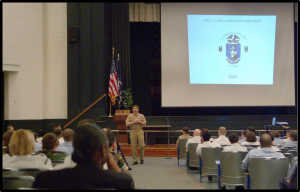
One core facet pertains to skill enhancement. Training endeavors are meticulously designed to augment the specific proficiencies and competencies requisite for various government job profiles. This encompasses both technical skills tailored to individual roles and softer skills, such as communication and leadership acumen, as well as adherence to ethical and legal norms.
Additionally, the onboarding process for new employees is facilitated through orientation and onboarding programs. These programs serve as an indispensable introduction to the organization’s mission, culture, policies, and operational procedures and ensure the seamless integration of newcomers into their respective roles.
Public personnel management advocates for a culture of professional development where personnel continually enhance their skills. This is actualized through opportunities for advanced training, certifications, and ongoing education, ensuring employees remain well-informed about industry developments and emerging trends.
Cross-training emerges as another noteworthy dimension, as it entails acquainting employees with diverse roles and functions within the organization. This strategy not only engenders workforce versatility but also assures operational continuity during staffing transitions.
Recognizing and nurturing leadership potential within the workforce constitutes a significant dimension known as leadership development. This facet equips aspiring managers and executives with the essential skills and proficiencies required to lead effectively in the public sector.
The domain of compliance and regulations is a pivotal training component. Employees are meticulously educated about legal, regulatory, and ethical standards to reduce the likelihood of any legal or ethical infringements.
In light of the ever-evolving technological landscape, comprehensive technology and innovation training ensure that employees are proficient in the utilization of emerging technologies and innovative tools, thereby bolstering productivity and efficiency.
In agencies where direct interaction with the public is routine, training programs underscore customer service skills. This guarantees that employees provide the public with responsive, courteous, and effective service.
Certain public sector roles necessitate specialized training in safety and emergency preparedness. Employees in positions such as law enforcement or emergency services are equipped with the skills required to navigate safety and security situations effectively.
Routine assessments and feedback mechanisms are essential in the realm of training. Through evaluation and feedback, organizations gauge the effectiveness of training programs, harnessing participant insights to refine and tailor training initiatives to specific requirements.
Employee training stands as an indispensable investment in enhancing the capacity and efficacy of the public sector workforce. Beyond individual performance improvements, it advances organizational objectives, augments public service delivery, and cultivates a culture of continuous learning throughout government agencies.
Management Development
Management development is an indispensable facet of public personnel management, focusing on cultivating and grooming future leaders within government entities. Its primary objective is to augment the skill set and competencies of individuals currently occupying leadership roles or aspiring to do so. These programs are meticulously crafted to ensure that participants possess the requisite skills and capabilities vital for effective management within the unique context of the public sector.
A major focus of management development programs centers on the refinement of leadership skills. These encompass a diverse array of proficiencies, including the ability to make informed decisions, communicate effectively, resolve conflicts judiciously, and engage in strategic thinking. Given the intricacies of challenges and decisions encountered in the public sector, these skills hold immense significance.

Succession planning is a pivotal facet of management development. Government agencies recognize its pivotal role in maintaining a seamless leadership transition. Identifying individuals with high potential and furnishing them with the requisite training and experiences ensures a ready pool of leaders capable of stepping into vacant positions.
Notably, management development programs are custom-tailored to suit the unique exigencies of the public sector. They take into account the distinctive challenges, regulatory constraints, and ethical considerations that invariably characterize the realm of government management.
Given the importance of ethical conduct and accountability in the public sector, management development encompasses components that focus on ethics, compliance, and transparency. These components are integrated to instill these values within future leaders.
A robust grasp of public policies and their ramifications is another critical facet of management development. Leaders are equipped with the knowledge and skills necessary to navigate the intricate political and policy landscape effectively.
As government agencies adapt to evolving societal needs and technological advancements, management development extends its purview to include training in change management and innovation. This prepares leaders to spearhead transformation initiatives adeptly.
Furthermore, given the multifaceted nature of public sector management, effective training in collaboration and stakeholder engagement is imperative. Public sector managers frequently collaborate with diverse stakeholders, including elected officials, community groups, and other government agencies. Management development programs impart strategies for fostering productive collaborations.
Routine evaluation and feedback mechanisms are incorporated into management development programs. Insights from program participants are instrumental in refining the curriculum and delivery methods to ensure ongoing effectiveness.

Mentoring and coaching play a pivotal role in management development, as emerging leaders are paired with experienced mentors or coaches. This one-on-one guidance aids individuals in navigating their career trajectories and addressing leadership challenges.
Importantly, management development is not a one-off endeavor but an ongoing journey. Public personnel management promotes a culture of continuous learning and professional growth among its leadership cadre.
In summary, management development is indispensable for nurturing a cadre of capable, ethical, and effective leaders within the public sector. By investing in the development of management talent, government agencies position themselves to tackle intricate challenges, deliver efficient public services, and uphold the tenets of sound governance.
Civil Service In Practice
The civil service system in the United States is a critical component of the federal government, providing the workforce necessary to carry out various functions, from national defense to healthcare administration. This system, established to ensure that federal employment is based on merit rather than political patronage, is characterized by the General Schedule (GS) classification and pay system, standardizing federal job categories and salary structures. Here’s an overview of how the civil service system works, including information on GS categories and steps.
The foundation of the civil service system lies in its commitment to merit-based recruitment, ensuring that federal employment decisions prioritize qualifications, skills, and experience over political affiliations. This fundamental principle aims to attract and retain the most qualified individuals for federal positions, fostering a professional and competent workforce.

Federal job positions are systematically categorized into various job series, grouping roles with similar responsibilities and requirements. This categorization encompasses a broad spectrum of occupations, ranging from administrative functions found in the GS-0300 series to specialized fields such as engineering, represented by the GS-0800 series.
Within the federal civilian workforce, the General Schedule (GS) stands as the predominant classification and pay system. Comprising 15 pay grades, from GS-1 to GS-15, this system introduces a tiered structure to employee compensation. Each grade incorporates multiple steps, typically numbering 10, with Step 1 denoting the lowest and Step 10 the highest. The GS system serves the vital purpose of standardizing pay levels consistently across federal agencies.
Compensation and career advancement for federal employees are intrinsically linked to their GS grade and step. Pay and promotion are contingent upon a myriad of factors, including job performance, experience, and tenure in service. Employee progression within the GS system entails both vertical advancement to higher grades and horizontal advancement within their existing grade by ascending through the steps. This advancement is typically facilitated through annual pay increases and exemplary performance evaluations.
In essence, the civil service system’s merit-based ethos, coupled with the comprehensive categorization of federal job positions and the GS classification and pay system, ensures that fairness, transparency, and opportunities for professional growth and development characterize federal employment.
Understanding GS Categories and Steps
GS categories represent the various occupational fields within the federal government. For example, the GS-1100 series includes positions related to contracting, while the GS-2200 series covers information technology management. Job seekers and federal employees can find job openings and descriptions within specific GS series on federal job websites.
| GS-1100: Business and Industry | |
| GS-1101 | General Business and Industry |
| GS-1102 | Contracting |
| GS-1103 | Industrial Property Management |
| GS-1800: Inspection, Investigation, Enforcement, and Compliance | |
| GS-1801 | General Inspection, Investigation, Enforcement, and Compliance |
| GS-1802 | Compliance Inspection and Support |
| GS1805 | Investigative Analysis |
| GS-1810 | Compliance Inspection and Support Student Trainee |
| GS-6000: Medical, Hospital, Dental, and Public Health | |
| GS-601 | Medical Aid |
| GS-602 | Patient Escort |
| GS-612 | Dental Assistant |
| GS-631 | Diagnostic Radiologic Technologist |
State and Local Systems
State and local governments in the United States have their own versions of personnel management systems, often modeled after the federal civil service system but adapted to meet state and local jurisdictions’ specific needs and structures.
Civil service systems at both the state and local levels in the United States are grounded in the core principle of merit-based hiring. This guiding principle prioritizes qualifications, skills, and experience over political affiliations, ensuring that government employment decisions are based on competence and merit.
In many states, these systems implement their own classification and pay structures akin to the federal General Schedule (GS). These state systems group job positions into categories or series, each associated with specific salary ranges and pay grades. Similarly, within these grades, multiple steps exist, allowing employees to progress in compensation based on performance and tenure.
To oversee and uphold these civil service systems, state personnel commissions or boards are established in several states. These independent bodies are tasked with maintaining compliance with merit principles, administering examinations, and addressing appeals related to personnel matters. In parallel, each state typically maintains its set of civil service rules and regulations, which govern diverse employment aspects, from recruitment and hiring to promotions and disciplinary actions. These regulations underpin a commitment to consistency, fairness, and transparency in personnel management.
State governments widely advertise job opportunities through official websites and centralized recruitment portals, granting candidates access to apply online and participate in competitive examination processes.
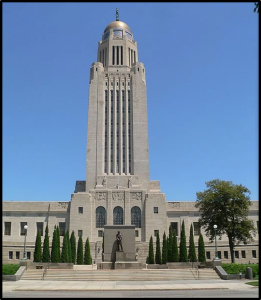
Furthermore, to nurture the skills and competencies of public employees, state civil service systems often offer comprehensive training and professional development programs. These initiatives foster career growth and bolster employees’ effectiveness in contributing to state government operations.
At the local level, civil service systems also flourish. Many cities and counties in the U.S. establish local civil service commissions or boards responsible for overseeing personnel management. These entities administer local civil service regulations, ensuring equitable employment practices and compliance with established rules.
Local governments craft their job classifications and pay scales to align with the unique needs of their communities. These systems categorize positions, define salary ranges, and structure pay grades and steps for employees.
Recruitment and hiring processes at the local level involve job postings, examinations, and interviews to evaluate candidates’ qualifications and suitability for positions. Additionally, local civil service systems handle employee relations matters, including grievances, disputes, and disciplinary actions, safeguarding employee rights and due process.

Many local government employees are part of labor unions or employee associations, fostering unionized workforces. Local civil service systems often engage in labor contract negotiations with these unions to address aspects such as wages, benefits, and working conditions.
While adhering to state laws and regulations governing public personnel management, local civil service systems ensure alignment with the broader principles of merit-based hiring and equitable employment practices. In essence, these state and local civil service systems remain essential pillars of effective and accountable governance, tailored to the specific needs and circumstances of their respective jurisdictions, thus serving the public interest and local communities effectively.
Other types of civil service jobs
Senior Executive Service (SES) in the GS system refers to the highest levels of employment within the federal government’s civilian workforce. The GS system is the primary pay scale used to determine the salaries of government employees. It consists of 15 grade levels, ranging from GS-1 (entry-level) to GS-15 (senior-level), and within this framework, there are steps that allow for incremental salary increases.
Senior Executive Service typically refers to employees who have reached the upper echelons of the GS pay scale, particularly those at the GS-14 and GS-15 levels. These individuals often hold significant leadership positions, are experts in their respective fields, and have many years of experience in government service. They may oversee large teams, manage complex programs, or provide critical advice to high-ranking officials.
One of the defining features of senior service in the GS system is the level of responsibility and influence these employees hold. They are often tasked with making important policy decisions, managing substantial budgets, and implementing initiatives that have a significant impact on government operations. As such, individuals in senior service roles are expected to demonstrate a high degree of competence, leadership, and professionalism.
In addition to competitive salaries, senior service employees may also enjoy additional benefits and opportunities for career advancement, reflecting their extensive experience and expertise in serving the public interest.
- Political Appointments: Some high-ranking positions in the federal government are political appointments, meaning they are filled by individuals appointed by the President or agency heads. These positions are not part of the GS system and do not have specific pay grades.
- Inspector General Positions: Inspector General (IG) positions oversee and investigate agency operations and activities. While not part of the GS system, these positions are often filled by individuals with extensive experience in law enforcement, auditing, or related fields.
- Presidential Appointees: Individuals appointed by the President to specific positions, such as Cabinet members or agency heads, serve at the highest levels of government and are not part of the GS system.
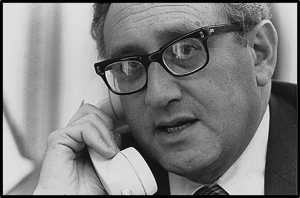
These alternative career paths and appointments can offer opportunities for individuals to serve at the highest levels of government beyond the GS-15 grade. The specific roles and qualifications for such positions vary widely, and they are often subject to political appointments and nominations.
Privatization
When a government privatizes jobs or services, it signifies the transfer of responsibilities for those jobs or services from the public sector (government agencies and employees) to the private sector (private companies or organizations). Government privatization of jobs or services is typically motivated by several factors. It may aim to achieve cost savings, with the belief that private companies can provide services more cost-effectively. Privatization allows governments to concentrate on their core functions while outsourcing non-core activities. Additionally, it may offer increased flexibility in scaling services based on demand, which can be challenging with a fixed government workforce.
Nevertheless, privatization also raises concerns, including the potential loss of public control, accountability, and the quality of services. Decisions regarding privatization should be thoughtfully considered in the context of each specific service and its impact on the public interest, as it often sparks debates and discussions.
Despite controversies surrounding privatization in personnel management, the George W. Bush administration strongly supported this practice. In 2001, the administration introduced the competitive sourcing initiative, requiring government agencies to provide evidence that their functions could be carried out more efficiently by government employees than by private contractors. This initiative classified over 800,000 federal government positions as “commercial,” necessitating agencies to prove their employees’ efficiency compared to private contractors or risk outsourcing the work. Between fiscal years 2003 and 2005, these competitions produced a net savings of $5.5 billion for the federal government, even though government employees were found to be more efficient than private contractors 83% of the time.
One modern example is the call to privatize Medicare. The proposal to privatize Medicare is a contentious and polarizing issue that has generated extensive debate among policymakers and the public. Advocates argue that privatization could introduce competition and efficiency into the healthcare system, potentially lowering costs and improving the quality of care. They contend that private insurance companies can offer more choices and innovative services to Medicare beneficiaries. However, opponents express concerns that privatization might lead to higher healthcare costs for seniors, reduce access to care for vulnerable populations, and prioritize profit over patient well-being. The debate over privatizing Medicare underscores the complex trade-offs between market-driven approaches and the need to ensure affordable, comprehensive healthcare for all Americans.

Contracting
Contracting public personnel involves outsourcing specific government functions or services to private entities but on a contract basis, keeping the ultimate control of the project with the government. Payment shifts from government employees receiving salaries and benefits to the government paying the contractor for the services rendered. The terms of payment are usually outlined in the contract and may be based on various factors like a fixed fee, performance-based metrics, or other negotiated terms.

Contracts also commonly include specific performance metrics and standards that the private contractor must meet. These metrics serve as benchmarks to ensure that the services are delivered at the expected level of quality and efficiency. Government agencies retain oversight and monitoring responsibilities to ensure that the private contractor adheres to the contract terms and meets performance expectations. Oversight mechanisms often involve audits, inspections, and reporting requirements.
One notable example of contracting occurred during the Iraq War, where over 125,000 government contractors were employed for various functions, including combat-related activities. This heavy reliance on private contractors raised concerns about their quality of training and their behavior and performance in the field, given their lack of regulation by the U.S. and Iraqi governments.
The competitive sourcing initiative faced challenges and resistance from government employee unions, statutory constraints, and limited funding availability in appropriation bills. As a result, the Bush administration scaled back its goals for competitive sourcing, allowing agencies to set more modest targets. Despite these obstacles, the initiative marked a significant shift in federal personnel policy, introducing competition into government functions and generating cost savings.
This practice has gained prominence as governments seek to enhance efficiency, reduce costs, and increase flexibility in delivering public services. Contracting can take various forms, such as outsourcing entire departments or specific tasks or hiring temporary workers through private agencies. While it offers several advantages, it also raises concerns about accountability and the protection of public interests.
One advantage of contracting public personnel may be cost savings. Private companies often claim to offer services at a lower cost than maintaining a government workforce with benefits and pensions. By tapping into specialized skills and resources available in the private sector, governments may be able to achieve greater efficiency and allocate resources more effectively.
The evidence regarding whether contracting out government services saves costs is mixed and context-dependent. The impact of contracting on cost savings can vary depending on several factors, including the nature of the service, the quality of the contract, the oversight mechanisms in place, and the efficiency of the private contractor. Here are some key considerations:
- Service Nature: Some services are more amenable to cost savings through contracting than others. Services that require specialized expertise, innovation, or scalability may benefit from private sector involvement. However, services that involve sensitive matters, significant public interest, or regulatory complexities may face challenges in cost savings.
- Quality of Contract: The effectiveness of cost savings often hinges on the quality of the contract itself. Well-structured contracts with clear performance metrics and incentives for efficiency are more likely to lead to savings. Poorly designed contracts or ones that lack competitive bidding can result in higher costs.
- Oversight and Monitoring: Robust oversight and monitoring mechanisms are crucial for realizing cost savings. Government agencies must actively monitor private contractors to ensure they adhere to contract terms, deliver services efficiently, and maintain quality. Inadequate oversight can lead to cost overruns and service quality issues.
- Efficiency of Contractors: The efficiency and effectiveness of the private contractor play a significant role. Competent contractors with a track record of successful service delivery are more likely to achieve cost savings. In contrast, poorly performing contractors can lead to increased costs.
- Economies of Scale: Contracting can introduce economies of scale, allowing private companies to provide services more efficiently by spreading fixed costs over a larger client base. However, these potential scale advantages are not guaranteed and must be carefully considered in the contract design.
- Transition Costs: The initial transition from in-house provision to contracting can involve significant costs, such as legal fees, employee severance packages, and contract negotiation expenses. These upfront costs may offset immediate savings.
- Long-Term vs. Short-Term Savings: The timeline for realizing cost savings can vary. While some savings may be evident in the short term, others may take longer to materialize. Long-term contracts may provide more substantial savings over time.
- Public vs. Private Workforce Costs: Comparing the costs of a public workforce to those of a private contractor is essential. Personnel costs, including salaries, benefits, and pensions, can differ significantly between the public and private sectors, impacting cost calculations.
- Local Conditions: Local economic conditions, labor markets, and regulatory environments can influence the cost-effectiveness of contracting. What works in one locality may not work in another.
However, contracting public personnel raises questions about accountability and transparency. As government functions are transferred to private entities, oversight and control mechanisms must be established to ensure that public interests are safeguarded. Concerns about potential conflicts of interest, inadequate service quality, and a lack of public accountability are common challenges associated with contracting.
In some cases, the decision to contract out public personnel may lead to job insecurity for government employees who face outsourcing threats. Labor unions and public employee associations often oppose such practices, fearing that they may erode job stability and labor rights.
Contracting public personnel offers potential benefits in terms of cost savings and flexibility, but it also poses challenges related to accountability and workforce stability. Decisions to outsource public functions should carefully consider the specific needs, costs, and potential risks associated with each case to protect public interests.
Public Sector Labor Relations
Unions, also known as labor unions or trade unions, are organizations formed by workers to represent their interests collectively, negotiate with employers, and advocate for better wages, working conditions, and benefits. Unions serve as a collective voice for employees, aiming to protect their rights and improve their workplace situations.

Unions are generally responsible for performing the following functions:
- Collective Bargaining: Unions engage in collective bargaining on behalf of their members. This involves negotiating employment contracts, known as collective bargaining agreements (CBAs), with employers. CBAs address various terms and conditions of employment, including wages, hours, benefits, job security, and workplace policies.
- Representation: Unions represent individual workers in disputes with employers, such as grievances related to workplace issues or disciplinary actions. Union representatives, often known as shop stewards, advocate for members’ rights and interests.
- Advocacy: Unions work to advance the rights and well-being of workers beyond the bargaining table. They may lobby for labor-friendly legislation, advocate for workplace safety regulations, and campaign for policies that benefit workers, such as minimum wage increases or family leave.
- Collective Action: Unions can mobilize workers for collective action, including strikes or work stoppages, to pressure employers to meet their demands. Strikes are a last resort when negotiations fail, and they can disrupt operations if many workers participate.
- Education and Training: Many unions provide educational and training programs for their members to enhance their skills and career prospects. These can include job-specific training, leadership development, and safety training.
- Solidarity: Unions promote a sense of solidarity among members, fostering a community of workers who support each other. Solidarity can be a powerful force in labor disputes and advocacy efforts.
- Legal Protections: Unionized workers often enjoy legal protections and rights, such as due process in disciplinary actions and the right to representation during meetings with management.
- Dues and Funding: Unions typically collect dues from their members to fund their operations and activities. These dues cover the costs of negotiations, legal representation, organizing efforts, and other union activities.
- Sectoral Coverage: Unions exist in various economic sectors, including manufacturing, education, healthcare, government, transportation, and more. Different unions represent workers in specific industries or occupations.
- International Associations: Some unions are members of international labor organizations, which allows them to collaborate with unions from other countries and advocate for global workers’ rights.
Foundations of Public Sector Labor Relations
Public sector labor relations, also known as public sector labor law, is a complex and evolving field that governs the relationships between government employers and employees. It encompasses the legal frameworks, rules, and regulations that define public sector employees’ and government agencies’ rights and responsibilities. We must explore the key milestones and developments shaping this field to understand its foundations and history.
The roots of public sector labor relations can be traced back to the late 19th and early 20th centuries when labor unions gained prominence in response to poor working conditions, low wages, and inadequate workplace protections in both the private and public sectors. Workers began organizing to bargain for better conditions collectively.
The first significant wave of government employee unionization occurred in the early 20th century when teachers and municipal workers formed unions. However, it wasn’t until the 1950s and 1960s that public sector unionization gained substantial momentum.
Challenges and Evolution
Public sector labor relations in the United States have experienced notable transformations over time, shaped by various challenges and considerations. These dynamics have emerged as both government entities and labor unions grapple with issues such as fiscal constraints, political influences, and the delicate balance between safeguarding employees’ rights and maintaining the efficiency of public services.
One of the defining features of public sector labor relations is the extension of collective bargaining rights to public employees. These negotiations encompass a broad spectrum of subjects, including matters related to compensation, working conditions, and job security. The evolution of collective bargaining has been instrumental in addressing the concerns and demands of public sector workers.
Occasionally, strikes by public sector employees, although relatively infrequent, have posed unique challenges to the continuity of essential public services. To resolve impasses arising from labor disputes, diverse mechanisms such as mediation, fact- finding, and arbitration have been employed. These mechanisms serve as critical tools in reaching agreements that are fair to both employees and the public.
Legal frameworks governing labor relations have also adapted over time to address specific issues. These include clarifications on the role of public safety employees, rules governing the collection of union dues or fees, and the protection of the rights of non-union members. These legal provisions contribute to the overall framework within which public sector labor relations operate.
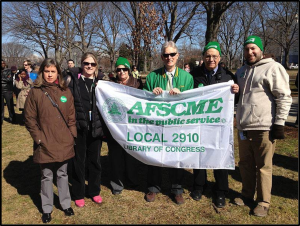
The landscape of public sector labor relations is not static; it is continually influenced by public opinion and the realm of politics. Shifting sentiments within the public and changes in political leadership can significantly impact labor policies and practices, as governments respond to the evolving expectations of their constituents.
In recent years, significant developments have been witnessed in public-sector labor relations. The U.S. Supreme Court’s landmark decision in Janus v. AFSCME (2018) is of particular note. This ruling prohibited collecting agency fees from non-union public employees, potentially altering the financial dynamics of public sector unions. Such developments underscore the ongoing evolution of labor relations within the public sector.
Bibliography
Ban, Carolyn and Norma Riccucci, eds. (1991) Public Personnel Management. New York: Longman.
Calomiris, C., & Schweikart, L. (1991). The panic of 1857: Origins, transmission, and containment. https://www0.gsb.columbia.edu/faculty/ccalomiris/papers/Panic%20of%201857.pdf
Civil Service Reform. Digital history. (n.d.). https://www.digitalhistory.uh.edu/disp_textbook.cfm?smtID=2&psid=3115.
Did you know… Samuel Swartwout skimmed staggering sums?. U.S. Customs and Border Protection. (n.d.). https://www.cbp.gov/about/history/did-you-know/samuel-swartwout.
Edwards, Chris (2010) “Public Sector Unions and the Rising Costs of Employee Compensation.” Cato Journal 30, No. 1: pp. 87–115.
Expansion. National Postal Museum. (n.d.). https://postalmuseum.si.edu/exhibition/networking-a- nation/expansion.
Fleisher, C. (n.d.). The efficiency of outsourcing. American Economic Association. https://www.aeaweb.org/research/government-outsourcing-dredging-industry.
Galbraith, John Kenneth (1952) American Capitalism: The Concept of Countervailing Power. New Jersey: Transaction Publishers.
Gore, A. (1993). Report of the National Performance Review. NSF. https://www.nsf.gov/pubs/stis1993/npr93a/npr93a.txt
Greenfield, Stuart (2006) “Public Sector Employment: The Current Situation.” Washington, DC: Center for State & Local Government Excellence.
Hays, Steven W. and Richard C. Kearney, eds. (1995) Public Personnel Administration: Problems and Prospects, 3rd ed. Englewood Cliffs, NJ: Prentice Hall.
Ingraham, Patricia and Carolyn Ban, eds. (1984) Legislating Bureaucratic Change: The Civil Service Reform Act of 1978. Albany: State University of New York Press.
Kellough, J. E., & Nigro, L. (2006). Organizational Culture and Leadership. http://www.untag- smd.ac.id/files/Perpustakaan_Digital_2/ORGANIZATIONAL%20CULTURE%20Organizational%2 0Culture%20and%20Leadership,%203rd%20Edition.pdf
Kingdon, John W. (1995) Agendas, Alternatives, and Public Policies, 2nd ed. New York: Longman.
Lasswell, Harold D. (1936). Politics: Who Gets What, When, How. New York: Smith.
Lindblom, Charles E. (1959) “The Science of Muddling Through.” Public Administration Review (spring).
Lipsky, Michael (1980) Street-Level Bureaucracy. New York: Russell Sage Foundation. Lowi, Theodore, J. (1979) The End of Liberalism, 2nd ed. New York: Norton.
Mosher, Frederick (1982) Democracy and the Public Service, 2nd ed. New York: Oxford University Press.
Mosher, William E. and J. Donald Kingsley (1936) Public Personnel Administration. New York: Harper.
Nixon, R. (2011, September 13). Government pays more in contracts, study finds. The New York Times. https://www.nytimes.com/2011/09/13/us/13contractor.html.
Office, U. S. G. A. (2022, November 14). Where Can Government Save Money? We’ve Found More than Half a Trillion Dollars in Potential Savings. U.S. GAO. https://www.gao.gov/blog/where- can-government-save-money-weve-found-more-half-trillion-dollars-potential-savings.
Rosenbloom, David H. and Jay Shafritz (1985) Essentials of Labor Relations. Reston, VA: Reston.
Shafritz, Jay M. (1973) Position Classification: A Behavioral Analysis for the Public Service. New York: Praeger.
Shafritz, Jay M. (1975) Personnel Management in Government: The Heritage of Civil Service Reform. New York: Praeger.
Smith, K. B. (2018). The Public Policy Theory Primer. Routledge, an imprint of Taylor and Francis.
The Presidency of Andrew Jackson. Digital history. (n.d.). https://www.digitalhistory.uh.edu/disp_textbook.cfm?smtid=2&psid=3544.
U.S. Merit Systems Protection Board. (2001). The U.S. Office of Personnel Management in retrospect: Achievements and Challenges After Two Decades. https://www.mspb.gov/studies/studies/The_US_Office_of_Personnel_Management_in_Retrospec t_Achievements_and_Challenges_After_Two_Decades_253640.pdf.
Media Attributions
- Andrew Jackson. Library of Congress © James Barton Longacre is licensed under a Public Domain license
- Swartout and Price. National Museum of American History © Henry R. Robinson is licensed under a Public Domain license
- The Result of the Star Route Trials © Friedrich Graetz is licensed under a Public Domain license
- Bill Clinton Walking with Vice President Al Gore on the South Lawn is licensed under a Public Domain license
- Individuals clean up a beach. National Institute for Occupational Safety and Health is licensed under a Public Domain license
- Pencil and test paper © Lecroitg is licensed under a CC BY (Attribution) license
- Petty Officer Leadership Symposium © Brandan W. Schulze. U.S. Navy is licensed under a Public Domain license
- Secretary of State Clinton and Gen. Martin Dempsey listen to Secretary of Defense Leon Panetta © Erin Kirk-Cuomo. is licensed under a Public Domain license
- Staff Sgt. Reginald Brooks (right), an observer-controller-trainer with 3rd Battalion, 345th Training Support Combat Service/Combat Service Support (3/345th CSS), teaches terrain recognition to recruits and potential recruits from the Atlanta Army Recruiting Station Sept. 12 at Fort Gillem. This file is a work of a U.S. Army soldier or employee, taken or made as part of that person’s official duties is licensed under a Public Domain license
- Employees having a discussion in an office © Steve Hillebrand. U.S. Fish & Wildlife Service is licensed under a Public Domain license
- Lincoln, Nebraska state capitol building © Ammodramus is licensed under a Public Domain license
- Passaic County, New Jersey One-Stop Career Center logo © Rogercozine is licensed under a Public Domain license
- Secretary of State Henry Kissinger © U.S. Photographic Office is licensed under a Public Domain license
- Dr. Donald Berwick, Administrator of the Centers for Medicare and Medicaid Services (CMS), talks with Washington DC seniors about Medicare’s Open Enrollment period © U.S. Department of Health & Human Services is licensed under a Public Domain license
- A Blackwater Security Company MD-530F helicopter aids in securing the site of a car bomb explosion in Baghdad, Iraq, on December 4, 2004, during Operation IRAQI FREEDOM. © Master Sgt. Michael E. Best, U.S. Air Force is licensed under a Public Domain license
- Chicago Teachers Union Day of Action Strike 4-1-16 is licensed under a Public Domain license
- AFSCME Local 2910, Library of Congress – Union members with banner is licensed under a CC BY-SA (Attribution ShareAlike) license

